Skoda Octavia Estate vRS
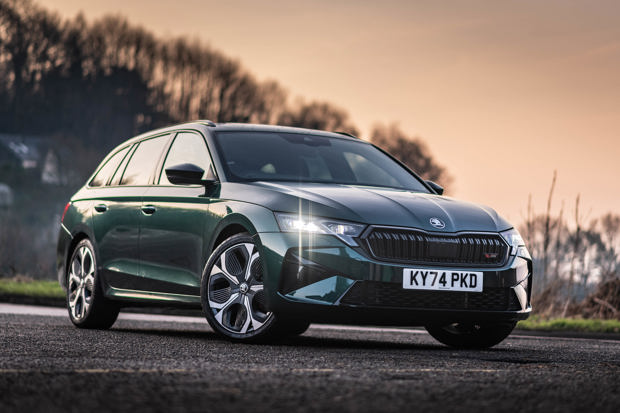
Skoda Octavia Estate vRS
- Run by: Phil Hall since February 2025
- Price when new: £40,390 (£43,290 including options)
- Engine: 2.0-litre petrol
- Power: 265PS
- 0-62mph: 6.5 seconds
- Torque: 370Nm
- Claimed economy: 40mpg
- CO2 emissions: 161g/km
- Insurance group: 27
- Report 1: Meet our new Skoda Octavia vRS long-term test car
- Report 2: Should you pick an Octavia vRS hatchback or estate?
- Report 3: What's the MPG like on the Octavia vRS?
- Report 4: Not everything is Simply Clever
- Report 5: Banishing the divisive aero wheel trim
- Report 6: Can an Octavia vRS rival a campervan?
- Report 7: One last road trip
- Report 8: It's a (brief) goodbye
Report 1: Meet our new Skoda Octavia vRS long-term test car
Meet our new Skoda Octavia Estate vRS long-termer as we're look to see if this is still all the car you'll ever need.
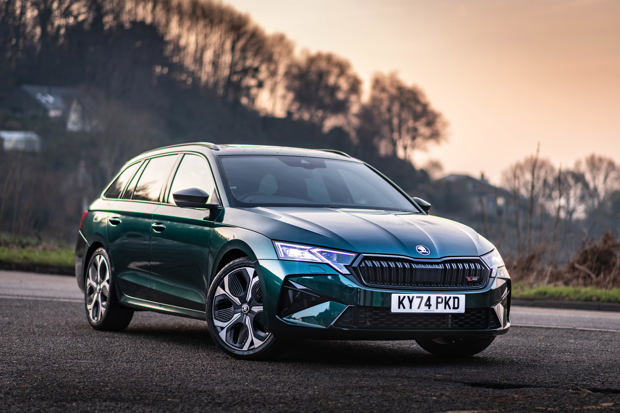
Date: 17 February 2025 | Current mileage: 2014 | Claimed economy: 40.3mpg | Actual economy: 37.8mpg
After 12 months of running various family SUVs, it's time to get behind the wheel of something a little different. So without further ado, please welcome the updated Skoda Octavia Estate vRS to the HJ fleet.
Confession time - I've always fancied running an Octavia vRS as on paper at least it seems to tick all the boxes for my needs. It promises to be practical, offer decent space for four people and enough performance to deliver everyday hot hatch (or should that be hot estate?) fun. It's easy to see why it's proved so popular over the years and it's why I'm really looking forward to spending the next 6 months with this fast family wagon.
So, as I've just alluded to, our long-termer is an estate. A hatch version is available, but just for that little bit more versatility, the estate wins for me. And fast estates are that bit cooler aren't they?
When initially launched back in 2020 the Octavia vRS was available with a choice of three engines - petrol, diesel and a plug-in hybrid, while a manual gearbox was also an option. For the facelift the engine range has been streamlined, with both the diesel and plug-in hybrid options dropped from the range. That just leaves the 2.0-litre TSI petrol engine that's now only available with a seven-speed DSG 'box, though power has been increased from 245PS to 265PS. That's no surprise as the mechanically similar Golf GTI has also benefited from the same power bump and loss of a manual gearbox. It's a smidge quicker than the older car, taking 6.5 seconds to hit 62mph - that's only 0.1 second slower than the Golf GTI. After enjoying some fairly frugal SUVs of late, the 2.0-litre TSI engine should return 40mpg officially, so it'll be interesting to see how this fairs in the real world.

So, what else? While the Octavia vRS does look the business in the punchy Hyper Green, we've gone for another green. Finished in Royal Green Metallic, I think it suits the car really nicely, delivering a sophisticated finish, though it is a £410 optional extra. And speaking of extras, our car also comes kitted out with the Assisted Drive Package Plus at £815, which comes with Speed Assist and Park Assist, as well as a panoramic roof at £1,675. One thing that is missing is the optional Dynamic Chassis Control (DCC), so it'll be interesting to see what it's like to live with daily without the extra cushioning that it can provide.
With all the extras that brings our Octavia vRS in at £43,290. Compared to the Octavia vRS we ran back in 2021, that's an increase of just over £7,000, while a Octavia vRS ten years ago would have set you back just £25,000. And because even the base price of the estate version of the vRS has crept over £40,000, it's now subject to the Expensive Car Supplement. This adds a further £425 a year to the standard rate between years two to six, bringing the total annual tax cost to £620.
Does it justify its more expensive price? That's one of the things we'll be exploring over the next few months, as well as how it copes with the demands put upon it as a fast family estate. First impressions though are very good, with the only worry that I'm getting a bit too attached already.

Report 2: Should you pick an Octavia vRS hatchback or estate?
We spent a week with an Octavia vRS hatchback to see how it compared to our estate. Here's what we learned.
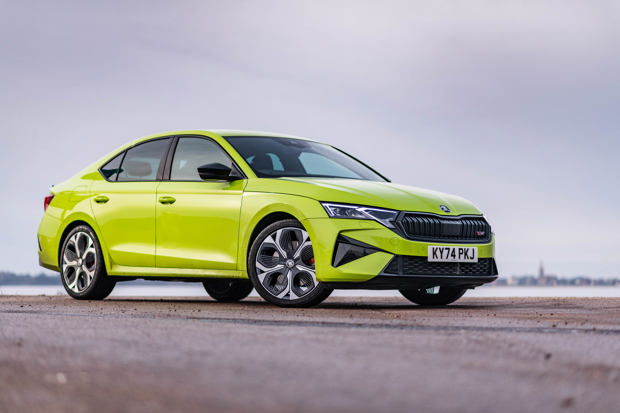
Date: 10 March 2025 | Current mileage: 2769 | Claimed economy: 40.3mpg | Actual economy: 39.6mpg
As I touched on in my first update, the Skoda Octavia vRS is available as both an estate and hatchback. Other than boot space, what's the difference? Just before our vRS estate arrived, we spent a week with a vRS hatchback to see how they differ.
Let's touch on the obvious difference, the boot, as it's probably the main reason why you'll look at the estate over the hatchback if space is your main concern. Our vRS estate has a huge 640 litres of space, with a large square load area. To be fair though, the vRS hatchback isn't that fair behind at 600 litres and you won't find anything as versatile as that in any other hot hatch. The boxier shape of the estate does make it a bit more useable for awkward shapes, while if you're taking the family dog with you, then the estate is the clear winner.
There are a couple of other external benefits that come with the vRS estate that might not be that obvious at first. It comes with roof rails for a start, so fitting bike racks to the roof becomes much easier and its something I'm looking at doing with our vRS estate long-termer. Call me flash, but you can't spec the vRS hatchback with a pano roof, and now the warmer weathers' arrived, it's a great feature to have on our vRS estate. It also makes the cabin feel a bit more airy as well.
What about the performance implications? If you want to have the smallest of bragging rights, then the vRS hatchback is quicker than the estate, being a whole 0.1 of a second quicker to hit 62mph. The slightly more slippery shape of the vRS hatch also makes it a bit more fuel efficient, though I'd doubt you'd even notice the 0.8mpg difference. Dynamically and you'd have to have the instincts of Senna to tell the difference between the two on the road.
Price then might be the deciding factor as the Octavia vRS hatchback starts at £39,295, while the vRS estate is over £1,000 more at £40,390. Crucially, and as I covered previously, the cost of the estate now nudges it into the additional 'expensive car supplement' that'll see you incur an additional tax cost of £425 in years two to six.
Ultimately it'll come down to which one you prefer the look of and what suits your needs. For me, the vRS estate's extra space and practicality are a winner for me.
Report 3: What's the MPG like on the Octavia vRS?
From short blasts to long trips, what kind of fuel economy can you expect from Octavia vRS?
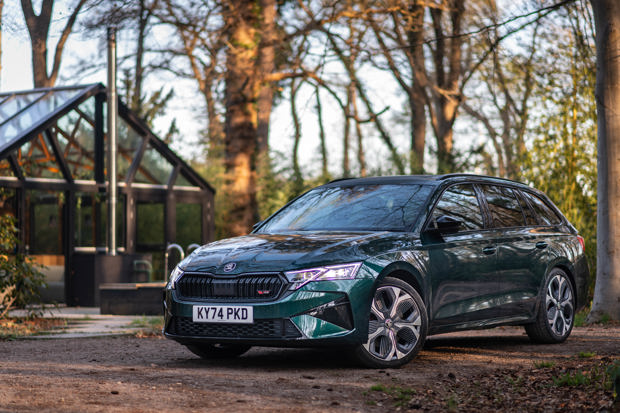
Date: 14 April 2025 | Current mileage: 3782 | Claimed economy: 40.3mpg | Actual economy: 43.4mpg
We me running a 265PS 2.0-litre petrol-engined fast estate, I accepted that fuel efficiency was going to take a bit of a dive compared to a more modest 1.5-litre family SUV I ran before, but what's it been like in reality?
We've been enjoying our Octavia vRS for a couple of months now and in that time we've managed to get a good idea of what it's capable of when it comes to MPG. Officially the Skoda Octavia vRS should be able achieve 40.3mpg, but we've been able to get even more from it on long runs.
A prime example is a recent family trip to The Netherlands, where the Octavia vRS really got to stretch its legs on a 700 mile round trip. Expectations were pretty low before setting off - this was the first time we'd really done a long journey with it fully loaded. With the boot packed tightly with two kids bikes and luggage, 40mpg seemed fanciful as we set off for the sixty odd mile drive down to Eurotunnel departures at Folkestone.
Enforced 50mph limited sections along stretches along parts of the M25 and M20 meant our Octavia's digital dash delivered some comforting news - from the start of our trip the average was just over 45mpg. That's one of the neat things with the data available on the digital display of the Octavia vRS - you can cycle through a number of metrics that includes both the average MPG since you set off, as well as a long-term average since you refuelled.

This all took a bit of a tumble when it was stop-start through Eurotunnel's passport control, but once under the channel and into France, the figures nudged up again as we cruised along at 130km/h in France and 120km/h in Belgium. The Octavia vRS shrugs off these speeds as well, ticking over at a couple of thousand revs and never feeling like it's being put under any strain.
More stop/start driving though round Antwerp's constantly congested ring road meant fuel economy took another dip, but The Netherlands' relaxed 100km/h speed limits meant we got to our destination averaging 43.4mpg and still with 70 miles of range in the tank. While a diesel would laugh at those kinds of figures, I'm more than happy with that, while it pretty much delivered the same kind of numbers on the way home as well.
That's just one trip, but what's it like to live with day-to-day? It's probably no surprise to hear that a mix of driving sees that average figure not reach those heady heights, with 33-34mpg more likely. If you're constantly in Sport or Manual mode it's going to be lower than that, while those regularly sitting in congested traffic won't be getting quite that either. Ultimately, if MPG is a primary concern, then you're probably looking at the wrong car, but for me it's a compromise worth making for the performance the Octavia vRS brings.
Report 4: Not everything is Simply Clever
Our Octavia vRS has lots of clever features, but one of which is causing real frustration.
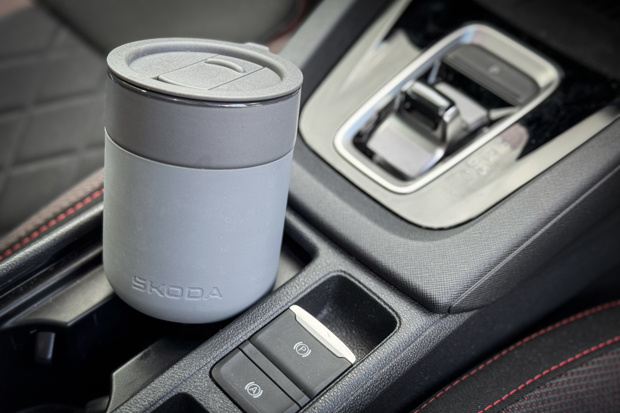
Date: 5 May 2025 | Current mileage: 4355 | Claimed economy: 40.3mpg | Actual economy: 43.7mpg
It's almost be twenty five years since the first 'Simply Clever' featured appeared on a Skoda - a pair of umbrellas neatly stowed away in the front doors of a Skoda Superb, and since then Skoda's really embraced this philosophy, designing and integrating some sixty-plus features into its cars.
And a lot of these features are genuinely useful little extras to have, and it's amazing that other car manufacturers haven't taken a leaf out of Skoda's book and done something similar. My Skoda Kodiaq I ran before my Octavia vRS had a load of Simply Clever features and a lot I found really helpful, and many of them have been replicated on the vRS.
This includes the umbrella in front door, though I've now got two - one in the driver's door and one in the passenger door. Then there's the parking ticket holder on the front pillar - while most parking spots seem to be paid for via an app, it's still a neat little idea when you do need it. There's also the ice scraper in the fuel filler cap (with also doubles up as a handy tyre tread gauge), while the washer fluid tank has a rudder lid that acts like a funnel when opened so you don't have to have the aim of a sniper when topping it up.
The Octavia vRS has a huge boot, but quite a lot of the time it's never that full, so there's the potential for stuff to roll around as you turn into a corner. Skoda's thought of this and as well as some foldout hooks to hang shopping bags on, ours comes with three additional nets that you can configure to section off parts of the boot.
I hate getting in a car if there's rubbish been left lying around, but the Octavia vRS comes with a compact waste bin in the door trim. There's now no excuse for my kids to leave sweet wrappers abandoned on the seats or my wife to leave apple cores loose in the door pockets.
All these things are great, but one thing that really frustrates me are the cupholders in the central console. Designed to hold a 500ml bottle of water and grip it firmly enough that you can open the lid whilst driving (which I appreciate is a neat idea), it means the size of the two cupholders won't accept any coffee cup (or water bottle) we take with us (including a fancy Skoda one). It's an odd one, as the Kodiaq had large cupholders that would easily hold two cups and while you can jam it in a door pocket, that's not very satisfactory when you're driving along. It also doesn't feel very sustainable either - surely it's better to use reusable cups and bottles than one-use bottles? It's not just me either - chatting to a friend who's got an Octavia and he was moaning about the same thing. It's a shame as it's the one cause of frustration on what is an otherwise very easy car to live with.
Speaking of which, after my last update about fuel economy a long 270 mile drive round the M25 and up the A1 saw my Octavia vRS hit an average of 48.3mpg.
Report 5: Banishing the divisive aero wheel trim
We liberate the aero wheel trim from our Octavia vRS.
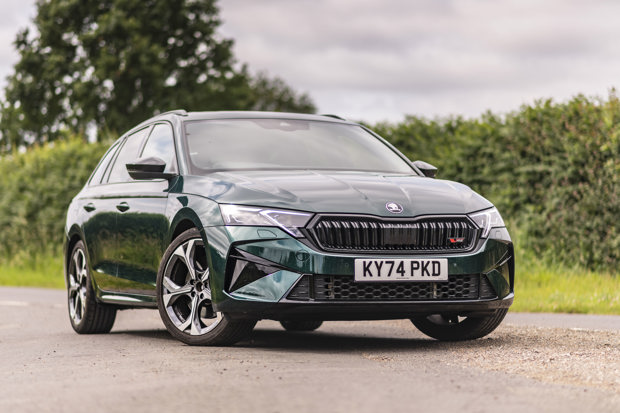
Date: 26 May 2025 | Current mileage: 4971 | Claimed economy: 40.3mpg | Actual economy: 39.6mpg
Okay, it might not be as striking as a Civic Type-R or as slick as a Golf GTI, but I really like the look of our Octavia vRS. But since its arrival, one thing has bugged me - the aero trim that cloaks a lot of the snazzy 19-inch Elias alloy wheels.
They just look a bit naff, and I'm not the only one. Showing a mate who owns a previous generation Octavia vRS and one of the first things he commented on were the wheels.
A bit of a quick search online brings up similar frustrations, so why has Skoda done this? It's all in the name of fuel economy - the trims are designed to help the Octavia vRS cut through the air a little bit better, with the end result better mpg. Interestingly though, the new Kodiaq vRS also has the same Elias wheels, but shuns the aero wheel trims. So I thought I'd see what our long-term Octavia vRS would look like without them.
The first challenge is getting the wheel covers off. A flick through the generic Octavia user manual that came with our vRS and there was no mention of how to remove these. A quick search online naturally came up with the solution.

In the boot and under the floor lies th spare wheel and jack, but easily missed is a small metal tool. I say tool, its a piece of thickish wire that's bent at one end and a loop at the other. All you have to do is tuck the bent end underneath the aero trim at the centre and give it a good yank with your finger.
The rest pops off fairly easily to reveal the naked 19-inch alloy wheel, with all four wheel trims resting on the driveway within a couple of minutes.
Stepping back to admire my handy work and expecting to be smitten with the new look, I wasn't taken with it as much as I thought I would be at first. I think some of it stems from me getting so used to seeing the car with the covers on - a sort of very odd Stockholm Syndrome if you will, while the absence of centre caps or bolt covers means it doesn't look quite finished.
It's growing on me though and if it was my own Octavia vRS, I'd be inclined to splash out of some proper centre caps and bolt covers for it and sacrifice a bit of mpg, consigning the aero trims to listing on eBay.
Report 6: Can an Octavia vRS rival a campervan?
Is the Octavia vRS a viable alternative to a campervan? We find out...
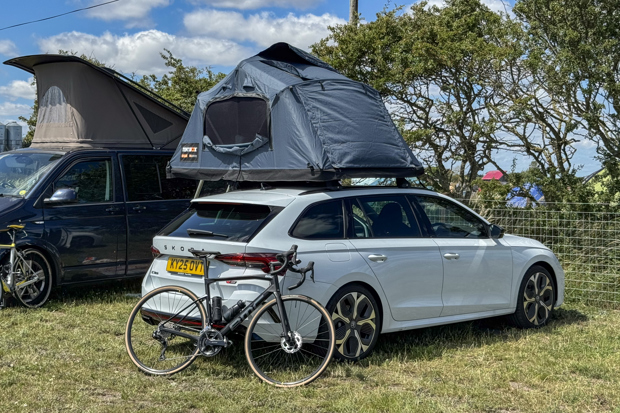
Date: 30 June 2025 | Current mileage: 6124 miles | Claimed economy: 40.3mpg | Actual economy: 38.7mpg
I recently tested a Volkswagen T7 California and after a weekend camping on the Suffolk Coast, we were all hooked. Having occasionally camped in tents for the last few years, the plush interior of the California in top-spec Ocean was far cry from our four berth tent.
VW Californias aren't cheap, while even used examples hold their values incredibly well, which means its a bit of an unrealistic dream at the moment. But could we get somewhere close with a roof tent on our Skoda Octavia vRS?
Fast-forward a couple of weeks and another Octavia vRS has arrived on my drive, this time with a tentbox perched on the roof. To be more precise, it's a TentBox Lite 2.0 that sleeps up to two people. With not enough space for the whole family (the company also produces the Lite XL - a 4-berth tent, with a super-king mattress that comfortably sleeps four adults evidently), I'm taking one for the team and testing it out myself as I head off cycling for the weekend with a mate.
It's fairly slab-sided thing, so it was no real surprise to discover that after the two-hour drive up to the campsite, the fuel economy took a bit of a hit, with the Octavia's average down to around 38-39mpg. Once on site though and the tent pops up in a matter of minutes and can be accessed via a ladder that’s stored inside the tent box when it’s closed. It’s actually quite luxurious up there as well, with storage pockets, fitted mattress and double skylights you can have open or closed.

The Octavia's boot 640-litre boot has already made it one of the best estate cars going and it meant I had plenty of space for other essential camping gear, as well as space to slide my bike in (with the rear seats folded).
If I wasn't taking my bike, or was using a tow bar-mounted rack instead, I could have tried out a neat little camping pod as well. Complete with a gas cooker, plenty of storage and yes, even space for a kitchen sink, it nestles in the boot and when you get to the campsite, you can drop the rear seats and assemble a double bed frame.
Put the tentbox together with cooking pod and on paper at least, the Octavia vRS provides many of the core camping features as the Volkswagen California. You can cook and wash under the shelter of the tailgate, while there's enough space to sleep four.
Compared to a purpose-built campervan, there are compromises to be made. It's not quite the luxurious camping experience you get in a California. It's a faff to get changed - there's nowhere to standup, while scrambling up and down the ladder can get tiresome. These irks might be easily overlooked though when to put the price of each setup side-by-side.
Our Skoda Octavia vRS starts at £41,070 and one essential optional extra I'd spec is an electric tow bar for £1095 - that way I can get bikes on the back. The TentBox is £1295 (or £1895 for the four-person XL version) and the EGOE Nestboard camping pod is around £3500, bringing the basic set-up in at £45,665. Heck, you don't even have to both with the pod - there are plenty of good camp stove tops around for a fraction of the price. Even the most basic T7 California starts at a shade over £63,000 for the Beach Camper.
That's quite a difference. The VW California is still the camping king, but if you're going to be an occasional camper, the Octavia vRS set-up might be the better option for some if you're prepared to compromise. When not camping you can pop the tent and camping pod in the garage, leaving you with excellent fast estate car for daily driving.
Report 7: One last road trip
We take our Octavia vRS on one last big journey before it heads back to Skoda.
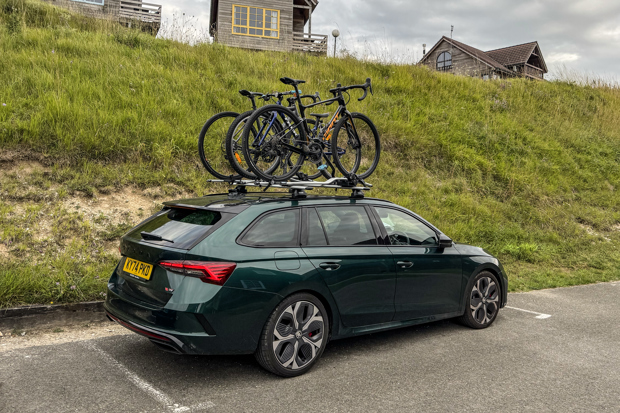
Date: 5 August 2025 | Current mileage: 6215 miles | Claimed economy: 40.3mpg | Actual economy: 32.6mpg
With only a few weeks left of Skoda Octavia vRS 'ownership', it seemed rude not to take it on one last big trip away, so a quick blast into France and then over in Belgium for a few days was on the cards.
We wanted to do some more cycling while we were away, but with my eldest daughter now on a bigger bike, we no longer had the luxury of being able to stuff two kids bikes in the boot. Plus, my wife and I wanted to take our own bikes this time round, so it meant decking the Octavia out with a bike rack.
My preference is for a tow bar mounted solution like the Thule Epos bike rack, but our Octavia vRS doesn't have the luxury of a tow bar (it's a £1095 option), so I was going to have to plump for a roof bike rack system.
I had a Thule WingBar Evo gathering dust in the garage, so a quick check on Thule's website revealed what adapters and feet I needed to marry the roof rack to the flush roof bars on the Octavia.
In a moment of weakness I ordered these from Halfords, and while the feet arrived when they said they would. the adapters went AWOL. After raising this and being assured I'd get a response in 48 hours, another call to them two days laters was greeted with promises that this was being 'escalated' and I'd hear back from them.
At this point I'd pretty much given up hope of seeing these adapters, so I ordered them from a specialist (which is what I should have done in the first place). All I wanted now was a refund from Halfords, but this could only be carried out evidently by either rejecting the courier delivering the package or driving to a Halfords to get a refund once it had been delivered.
With no sign of it even being dispatched on the tracker this meant getting a refund was looking tricky. With still no word from Halfords customer services some three days after raising the issue initially, I made another call and finally managed to get a refund after a robust conversation.
Back to the roof rack and setting aside an hour or so, this was pretty easy to install along with three bike racks. Roof racks on a SUV can be a bit of a pain, but the lower height of the Octavia meant it was that bit easier to lift bikes on to. Don't get me wrong, it's still a bit of a faff juggling them it place compared to a tow bar rack, but it's still a one-person job.
With the bikes loaded on the roof (and one in the boot), we set off. If you've never driven with bikes on the roof, it's easy to forget they're there. Which probably explains why you hear horror stories of people forgetting they're on the roof and trying to get through a height-restricted barrier.
The Octavia's panoramic roof though meant I could glance upwards to check all three were present and correct, but I didn't really need visual confirmation to be reminded they were on there as all I had to do was look at the average fuel economy.
While I've been easily able to get above 40mpg on long runs in the past, this was a distant memory with three bikes perched on the roof. While it wasn't that bad on slower sections of road, as soon as you hit the motorway, things took a bit of a nosedive. The result was that we only managed about 32mpg over the journey down. I'm just glad we weren't traveling that far - a longer trip south would have got pretty pricey.
That aside and the Octavia vRS didn't put a foot wrong - it's brilliant as a family cruiser and a car we're getting more attached too.
Report 8: It's a (brief) goodbye
Our time's up with the Octavia vRS...or is it?
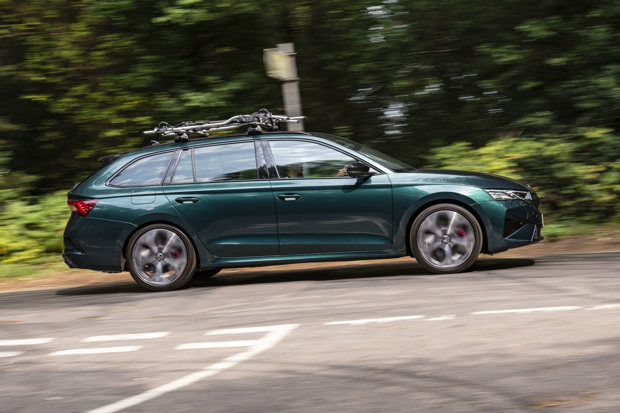
Date: 26 September 2025 | Current mileage: 6891 miles | Claimed economy: 40.3mpg | Actual economy: 39.8mpg
Normally when it comes to a final long-term update, there's a bit of a formula. I'd probably start by telling you that the man or woman from Skoda has come to pick up my Octavia vRS, and then rattle off some reasons why we've loved living with it, some of the things that have irritated us, before summing-up just how well (or not) it's fitted in with us over the past few months. But things have panned out a little differently with our Octavia vRS.
It's true, a very nice man from Skoda's logistics team knocked on my door, took the keys and drove off in it. Normally, with a car that we've gelled with so much after six months, this would be a bit of a wrench, but the Octavia vRS was only returning back to HQ for a couple of weeks.
And that's the twist. It's only going back to get a bit of a spruce up and a neat retractable tow bar fitted before coming back 'home'. That's because we're now the proud owners of it...it's now officially 'our' Skoda Octavia vRS.
Let me explain. With its return looming we realised that an Octavia vRS ticked a lot of boxes for us as family. For starters, the size is just right - there's ample space for the four of us, while the boot is a properly useful size (while it's good for the dog as well). It's probably one of the key reasons for choosing it over something like a Golf GTI as well. And while that extra bit of space might dull its driving focus compared to some rivals, it can still be really good fun on the right road.
This is certainly helped by the 2.0-litre turbo-petrol engine at the heart of the Octavia vRS. It's a brilliant performer and really suits the car - there's ample performance to make it sensibly quick. It doesn't lend itself to pootling round town too often, but fully loaded and long runs have seen us happily edge over 40mpg.
It's also been really easy to live with. Ignoring the touchscreen climate controls and everything is easy to find and navigate around, while driver assistant aids can be easily turned off.
The Octavia vRS might lack the dramatic styling of some rivals, but I like its sharp but understated looks, while I'm a big fan of the metallic royal green paint ours is finished in. Which is also one of the reasons why we've ended up with this particular car - looking around and its a rare colour surprisingly, with most pre-owned options in striking hyper green, blue, red or black.
One sticking point though was a tow bar. After putting bikes on the roof for our recent trip to France, I'd made the decision that if we were to get our own car, I'd want to stick a bike rack on a tow bar. And I didn't want something permanently jutting out the back. Luckily the good people at Skoda were able to retrofit a retractable tow bar - it pops out when you press a button in the boot, and then disappears back under the car when not in use.
The only thing I need to do now is find a coffee cup that'll fit in the tiny cupholders in the central console. Otherwise I can't think of much more praise for a car than by buying one.

